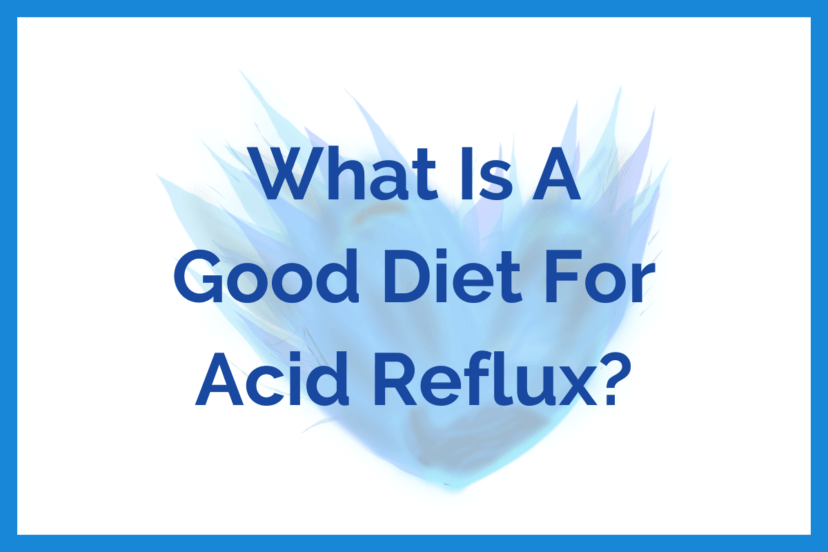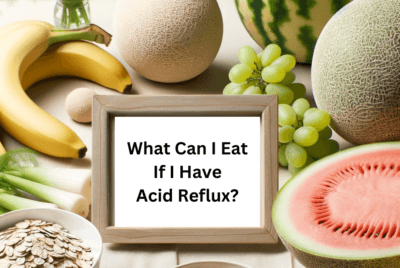What Is A Good Diet For Acid Reflux?
Having experienced acid reflux first-hand, I know the burning chest pain, nausea and other symptoms can really disrupt life’s simple pleasures like eating favorite foods. As someone who has found relief through diet and lifestyle changes, I want to provide helpful, practical advice for managing acid reflux naturally. In this detailed article, we’ll explore foods to avoid, better food choices, and lifestyle tweaks that have provided lasting relief for many suffering from GERD.
Table of Contents
Introduction – Finding A Good Diet For Acid Reflux
Acid reflux stems from a faulty valve that allows stomach contents to splash up into the esophagus, causing unpleasant symptoms. The good news is relief is often possible through simple diet and lifestyle modifications without relying on medications long-term.
Keeping a detailed symptom journal is one of the best ways to uncover your unique triggers and guide dietary choices. Note exactly what foods, beverages or activities seem to provoke symptoms, as well as what provides relief. Over time, clear patterns will emerge showing your problem foods. Some common culprits are spicy fare, citrus fruits, tomatoes, coffee, alcohol and anything fried or fatty. On the flip side, foods like bananas, oatmeal, lean proteins and steamed vegetables are usually safe.
I suggest gradually phasing out major triggers, especially around bedtime when acid reflux tends to be worse. Substitute items like herbal tea for coffee, extra virgin olive oil for vegetable oil when cooking, and roasted veggies instead of raw. Small, incremental swaps like these often lead to big improvements in daily symptoms. While it can be hard to give up favorite indulgences, your health and wellbeing is worth it.
What Exactly is Acid Reflux?
Also called gastroesophageal reflux disease (GERD), acid reflux is a common digestive disorder where stomach acid or bile flows back into the esophagus and irritates the lining. This backflow of acid is called reflux.
A ring-shaped muscle called the lower esophageal sphincter (LES) acts as a valve between the esophagus and stomach. It normally tightens after swallowing to prevent contents from coming back up. But when the LES relaxes inappropriately or loses tone, acid can escape the stomach and cause symptoms.
The most common symptom is a burning discomfort known as heartburn. It’s often worse after eating, when lying down, or bending over. Other signs of acid reflux include:
- Regurgitation
- Bloating
- Bloody stools
- Nausea
- Chronic cough
- Hoarseness
- Sore throat
- Wheezing
- Chest pain mimicking a heart attack
If left untreated, acid reflux can lead to complications like severe inflammation and ulcers in the esophagus. It can also cause Barrett’s esophagus, a precancerous condition that increases the risk of esophageal cancer.
While antacids and other medications can temporarily neutralize stomach acid and provide short-term symptom relief, they don’t address the underlying cause of reflux. For lasting results and prevention of complications, diet and lifestyle changes are often the best remedy.
Why Diet is So Important for Controlling Reflux
Diet plays a major role in controlling acid reflux symptoms because certain foods and beverages directly affect the functioning of the LES valve and the level of acidity in the stomach.
Some foods and drinks relax the LES, which allows more acid to splash up into the esophagus. They can also directly irritate the esophageal lining. Fried and fatty foods delay stomach emptying, which causes excess pressure on the LES. Spices and acidic foods like citrus can further inflame the esophagus.
On the other hand, some foods can actually help strengthen the lower esophageal sphincter, absorb excess stomach acid, and balance the pH in the gut. Foods like oatmeal, bananas, lean proteins and vegetables fall into this category.
By carefully paying attention to diet and identifying triggers, many acid reflux sufferers are able to control symptoms and avoid medications long-term. Dietary and lifestyle remedies get to the root cause and provide lasting relief without side effects.
Foods to Avoid with Acid Reflux
Now let’s get into detail on which foods and drinks are common acid reflux triggers. Try eliminating or reducing these items to see if it provides relief:
Spicy Foods
Spicy foods like hot peppers, chili, hot sauce, curries, and Cajun or Creole seasoned dishes are frequent acid reflux triggers.
The compounds that give these foods their heat – capsaicin, capsicin and piperine – have been shown to relax the lower esophageal sphincter muscle and increase the risk of reflux. Spicy seasonings containing cayenne or red pepper can have the same effect.
Spicy fare also contains irritating compounds that can inflame the esophagus directly on contact. This one-two punch makes heavily spiced food a top item to avoid for those with chronic acid reflux.
Fried Foods
French fries, onion rings, chicken fingers, mozzarella sticks and other deep-fried foods often spell trouble for heartburn sufferers.
The high fat content of fried foods causes food to remain in the stomach for longer. This puts pressure on the LES valve and increases the risk of acid reflux occurring. Fatty foods stimulate more acid secretion as well.
Of course, the type of cooking oil used matters too. Vegetable oil, canola oil, corn oil and other polyunsaturated fats used for frying produce inflammatory compounds that can worsen acid reflux. Using healthier fats like olive oil reduces this risk. But in general, fried foods are best limited or avoided altogether.
Citrus Fruits
Acidic foods like lemons, limes, grapefruit and oranges are frequent heartburn triggers due to their high citric acid content. The sour taste of citrus comes from the citric and ascorbic acid that can directly irritate the esophagus.
Some experts recommend limiting intake of citrus to approximately one serving per day at most for acid reflux patients. It’s best to avoid citrus altogether during active reflux flares.
Lemon and lime juice are especially bothersome due to their highly concentrated acidic juices. If cooking with citrus juice, be sure to measure carefully and limit portions.
Tomatoes
Like citrus fruit, tomatoes are highly acidic and often bothersome for those with GERD. Tomatoes contain citric acid, malic acid and oxalic acid that can trigger unpleasant reflux symptoms.
Tomato-based products like pasta sauce, salsa, ketchup and tomato juice are common culprits. Raw tomatoes are especially likely to cause problems due to their firm skin and seeds, which can scrape and irritate the esophagus.
If eliminating tomatoes entirely seems too difficult, try roasting or grilling tomatoes as this can make them easier to digest. Opt for lower acid tomato varieties like Roma or cherry tomatoes as well. And be sure to limit portion sizes of tomato-based foods.
Alcohol
All types of alcohol have the potential to trigger acid reflux symptoms due to their direct effects on the esophagus. Beer, wine and liquor relax the lower esophageal sphincter, increasing the likelihood of acid reflux occurring.
Alcohol also stimulates the stomach to produce more acid. And carbonated alcoholic drinks like beer and champagne introduce gas that can force open the LES valve.
Red wine is one of the worst offenders because it contains high amounts of tannins that are known to cause stomach irritation. But white wine, clear liquors, beer and other types of alcohol can cause problems too.
Moderation is key if you choose to drink alcohol, but those with chronic heartburn are often better off avoiding it altogether. Limiting intake to one drink or less per day with food is recommended if you choose to imbibe.
Coffee and Tea
Caffeinated beverages like coffee, black tea, and green tea negatively affect acid reflux due to their caffeine content. Sodas with caffeine have the same effect.
Caffeine has been shown to relax the lower esophageal sphincter muscle, allowing acid to escape more readily. It also stimulates stronger gastric acid secretion, worsening reflux.
The acids present in coffee beans, tea leaves and cocoa can irritate the stomach lining as well. Coffee in particular enhances production of stomach acid.
Carbonated sodas and seltzer introduce gas that can force open the faulty LES valve. Chocolate and mint may also relax the LES for some sufferers.
The best approach is to gradually switch to decaffeinated coffee and herbal caffeine-free teas to see if it provides relief. Limiting intake of caffeinated beverages to 1-2 cups per day with meals is recommended if eliminating them entirely seems too difficult.

Helpful Foods for Acid Reflux Relief
While some foods make acid reflux worse, others can actually help calm symptoms. Here are some smart food choices to incorporate:
Oatmeal
A hot bowl of old-fashioned or steel-cut oatmeal is a great way to start the day for those with acid reflux. Oats contain a soluble fiber called beta-glucan that helps absorb excess stomach acid and reduce symptoms.
The whole grains also contain compounds that balance acidic pH levels in the gut. Studies show oats help improve the barrier between the stomach and esophagus as well.
To reap the benefits, avoid highly processed instant oatmeal and stick to less refined steel-cut or old-fashioned varieties. Top your oats with plant-based milk or yogurt and fruits like bananas or berries for added nutrition without irritating acid reflux.
Bananas
Bananas are a low-acid, high-fiber fruit that makes for a smart choice for people with GERD. Bananas aren’t acidic at all and are one of the few fruits that don’t provoke symptoms in most sufferers.
Ripe bananas contain compounds called fructooligosaccharides that can help boost digestive enzymes and reduce stomach inflammation caused by acid reflux.
Bananas also act as a natural antacid thanks to their high potassium content. The potassium helps balance stomach acidity and regulates pH levels. Enjoy them fresh as a snack a few times per day or add to smoothies, oatmeal and yogurt. Just be sure they are ripe.
Lean Meats
Chicken, turkey and lean cuts of red meat like sirloin are usually well-tolerated by those with acid reflux, especially when not fried. Choosing grass-fed and organic varieties when possible is healthiest.
These lean meats don’t cause excess fat and pressure on the LES valve like fatty cuts, fried meats and processed deli meats. They also aren’t marinated in spices that can irritate symptoms.
Stick to grilling, baking, broiling or poaching lean meats. Pair with low-acid vegetables like broccoli, greens, cucumbers, cabbage or squash and a healthy whole grain like brown rice. This makes for a satisfying, reflux-friendly dinner.
Non-Starchy Vegetables
Most non-starchy vegetables are safe for people with acid reflux to enjoy freely. Good options include leafy greens like spinach, kale and lettuce, cruciferous vegetables like broccoli, cauliflower and Brussels sprouts, as well as asparagus, carrots, green beans, celery, squash and zucchini.
These fiber-rich veggies help absorb excess stomach acid. They also provide vitamins and antioxidants to help promote healing of irritated esophageal tissue.
Steaming, grilling, roasting or sautéing veggies in a little olive oil is best. Top salads with olive oil and lemon juice-based dressing instead of creamy, fatty dressings to avoid triggers.
Healthy Fats
While fried and unhealthy fats are problematic, adding small amounts of certain healthy fats can actually help calm acid reflux symptoms for some.
Extra virgin olive oil contains beneficial plant compounds that may increase LES pressure and limit acid reflux. Using olive oil for low-temperature cooking and drizzling over salads and veggies is a smart choice.
Nuts like almonds, walnuts and flaxseeds help balance pH levels thanks to their fiber, vitamins and minerals. Nut butters make a good replacement for butter on toast for those with acid reflux.
Avocados are loaded with fiber and nutrients that can help reduce stomach inflammation. Enjoy a few slices per day on salads or sandwiches.
This study evaluated the adherence to dietary guidelines among patients with GERD. The results showed that many patients with GERD do not adhere to recommended dietary guidelines, which may contribute to the persistence of symptoms. The study emphasizes the importance of dietary modifications in the management of GERD.
Dietary and Lifestyle Factors Related to Gastroesophageal Reflux Disease: A Systematic Review
Lifestyle Tweaks for Better Acid Reflux Management
Along with diet, certain lifestyle habits can significantly impact acid reflux as well. Here are some tips for reducing symptoms:
Don’t Eat Large Meals
Eating smaller, more frequent meals throughout the day puts less pressure on the LES valve compared to eating 1-2 large meals. Overloading the stomach increases the risk for reflux.
Aim for 5-6 small meals spaced 2-4 hours apart. Make sure to chew each bite thoroughly to aid digestion, and don’t rush while eating which can lead to gulping air and bloating.
Allow 3 Hours Before Lying Down
Lying down too soon after eating makes it easier for acid to travel back up the esophagus. Gravity is no longer working in your favor.
Try standing or walking for at least 3 hours after larger meals to allow for complete digestion and stomach emptying. This also prevents discomfort trying to sleep on a full stomach.
Lose Excess Weight
Carrying extra pounds increases the pressure on the LES valve, especially if you carry weight in the abdominal area. Losing weight can bring major improvement in reflux symptoms.
Even a modest 10-15 pound weight loss can provide significant relief. Consult your doctor about the best diet plan and exercise regimen for your situation.
Quit Smoking
Smoking damages the esophageal sphincter over time and reduces LES pressure. This makes reflux more likely. Quitting smoking allows the esophagus time to heal and improves symptoms for many reflux sufferers.
Don’t Wear Tight Clothing
Avoid tight belts, skinny jeans and slim-fitting tops that put pressure on the stomach area. This can force open the esophageal valve and allow acid to escape upwards. Wear loose, comfortable clothing around the midsection to prevent reflux flares.
Raise the Head of Your Bed
Elevating the head of your bed at least 6 inches helps use gravity to keep acid down in the stomach where it belongs – especially helpful at night.
You can place sturdy blocks under the bedposts or use a wedge pillow insert under the mattress to gently incline the upper body while sleeping. This simple trick prevents waking up to nighttime heartburn.
When it’s Time to See a Doctor
While diet and lifestyle adjustments can help control mild to moderate acid reflux symptoms for many, more severe GERD requires medical attention. Contact your doctor if home remedies aren’t providing lasting relief.
Testing for complications like strictures, ulcers or precancerous cell changes in the esophagus may be warranted. Be sure to seek medical care if you experience any of the following:
- Difficulty or pain when swallowing (dysphagia)
- Unexplained weight loss
- Vomiting or see blood in vomit
- Black, tarry stools
- Feeling like food gets stuck in your throat or chest
- Persistent hoarseness or laryngitis
- Chronic sore throat
- A cough that won’t go away
- Wheezing or asthma flare-ups
- Chest pain that mimics a heart attack
For moderate cases, acid-reducing medications may be prescribed to decrease stomach acid production. With severe long-term GERD that doesn’t respond to medication, surgical procedures like fundoplication can help strengthen the LES valve.
Don’t hesitate to take your stubborn symptoms to a gastroenterologist. Getting to the root cause with proper testing brings lasting relief.
Conclusion
Acid reflux can detract from life’s simple pleasures, like enjoying favorite foods and drinks. By paying close attention to your unique dietary triggers, making thoughtful food swaps and implementing lifestyle changes, lasting relief is possible for many.
Small steps like having an alkaline breakfast, wearing loose clothing, and waiting 3 hours before lying down after meals cumulatively make a big difference. Don’t get discouraged if it takes some trial and error to see improvement. Stick with it and you’ll likely find lasting freedom from the flames of acid reflux.
Here’s to healing your body and enjoying all of life’s moments free from GERD! Wishing you the very best.
FAQs
What drinks are safe for acid reflux?
Water, plant-based milk, herbal tea and diluted fruit/veggie juices are gentle beverage choices. Avoid coffee, carbonated drinks and alcohol.
Are occasional “cheat” foods ok?
An occasional dietary indulgence won’t sabotage progress if you get right back on track. Just be mindful of portion sizes, timing and your unique triggers.
What supplements help combat acid reflux?
Ginger, licorice and slippery elm may provide relief for some when used for short periods. Check with your doctor before trying supplements, especially when taking other medications.
Is green tea ok with acid reflux?
The small amounts of caffeine in green tea may trigger symptoms for some. Substitute with ginger or herbal caffeine-free teas to be safe.
What food provides the fastest relief?
Cold milk can temporarily buffer stomach acid and soothe symptoms for some, although dairy triggers reflux in others. Bananas and oatmeal also tend to provide quick relief.




